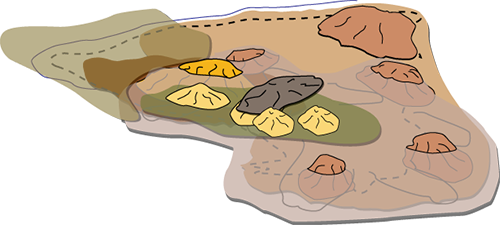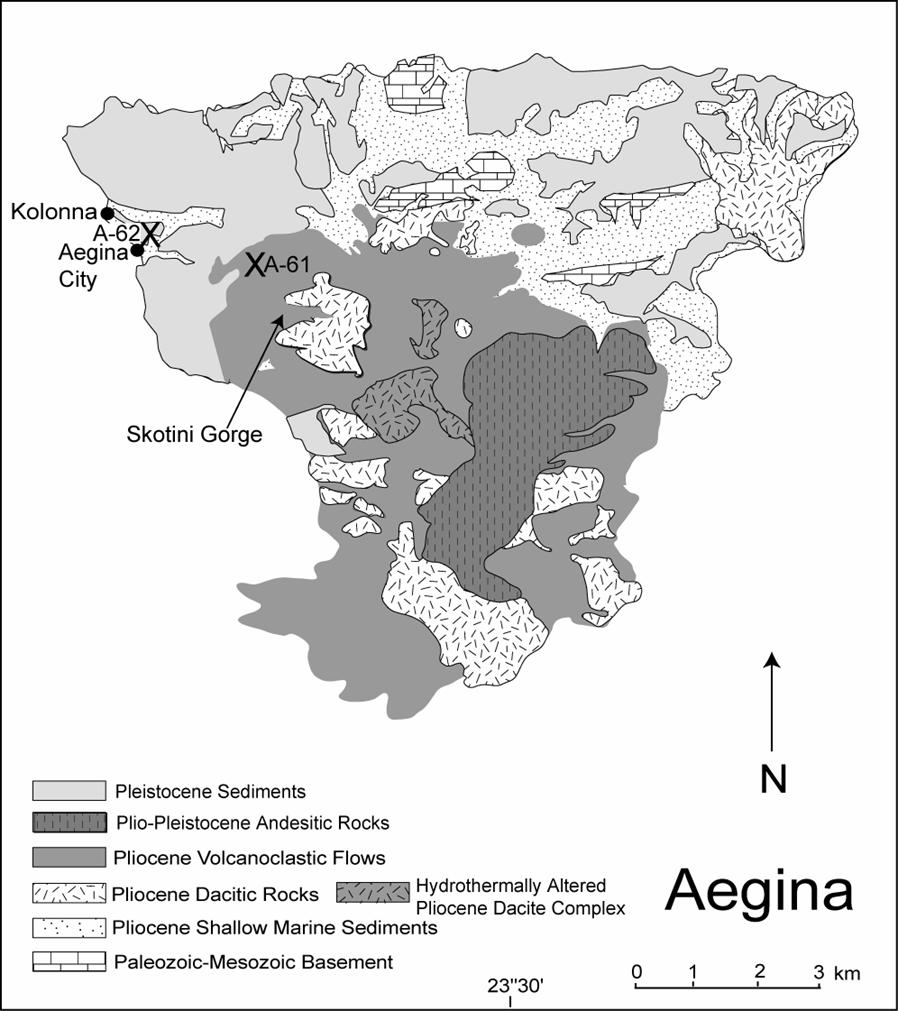

HOME | INTRODUCTION | J. BROPHY | C. SHRINER | GEOCHEMICAL DATABASE | SEARCHABLE DATABASE
AEGINA ISLAND HISTORY | BIBLIOGRAPHY | FUNDING | FIELD WORK | IMAGE DATABASE
![]()
Aegina Island Geologic History
The geology of Aegina Island is of fundamental importance to our overall study of provenancing Aeginetan Ware artifacts to specific source localities on the island. This brief summary is based largely on the bedrock mapping of Dietrich et al. (1991) and the recent age dating of Morris (2000).
Aegina Island is a Plio-Pleistocene (4 my to 1 my ago) volcanic island located approximately 15 miles south of Athens in the Saronic Gulf. The geology of Aegina is primarily that of overlapping dacitic and minor andesitic eruptive centers that have formed at or near sea-level.

This illustration schematically outlines the geologic evolution of Aegina island. The first and largest series of eruptions occurred during Pliocene times and formed Skotini volcano which, presumably, was entirely surrounded by extensive coastal plain deposits (Stage I). Subsequent activity created several overlapping centers of Pliocene age, each with their own surrounding apron of coastal plain deposits, which together buried all but the western and southwestern part of the Skotini coastal plain deposits (Stage II). Shortly after construction the entire composite edifice collapsed, burying all but the north western part of the island under widespread Pliocene age volcaniclastic flows. The only coastal plain deposits to remain uncovered were the northwestern most Skotini deposits (Stage III ). The final eruptive events consisted of small volume, Plio-Pleistocene age basaltic to andesitic eruptions (Stages IV and V) which are much less likely to generate large volumes of pyroclastic deposits. Westward tilting of the entire island during the Pleistocene led to marine deposition of the Poros limestone over the still exposed Skotini coastal plain sediments on the northwestern side of the island, and whole scale erosion of whatever coastal plain deposits might have existed on the eastern side of the island (Stage VI). Finally, uplift and erosion has brought the island to its current state.
![]()
 This geologic evolution has played a critical role in determining where potential clay source material for Aeginetan Ware would have existed in early Bronze Age times. Given the large volume and long duration of Aeginetan Ware production, it is likely that the Kolonna craftsmen required a large and constant supply of clay material. Within the different volcanic environments that characterize Aegina, the only one that is capable of yielding such large volume clay deposits would be the coastal plain sediments. From the map on the right, one can see that the only remaining such sediments are those associated with Skotini volcano and are exposed along the northwest portion of the island, close to the ancient site of Kolonna. Thus, any attempts to locate the source clays for Aeginetan Ware should probably be concentrated in this part of the island.
This geologic evolution has played a critical role in determining where potential clay source material for Aeginetan Ware would have existed in early Bronze Age times. Given the large volume and long duration of Aeginetan Ware production, it is likely that the Kolonna craftsmen required a large and constant supply of clay material. Within the different volcanic environments that characterize Aegina, the only one that is capable of yielding such large volume clay deposits would be the coastal plain sediments. From the map on the right, one can see that the only remaining such sediments are those associated with Skotini volcano and are exposed along the northwest portion of the island, close to the ancient site of Kolonna. Thus, any attempts to locate the source clays for Aeginetan Ware should probably be concentrated in this part of the island.
![]()
Last Updated:
July 1, 2014
Copyright, Indiana University 2009